HI6028 Taxation Assignment: Comprehensive Analysis of Taxation Issues
VerifiedAdded on 2022/11/29
|9
|2008
|265
Homework Assignment
AI Summary
This assignment solution addresses two key taxation issues: the claimability of Input Tax Credits (ITC) under GST and the capital gains tax (CGT) consequences of various transactions. The first issue analyzes whether The City Sky Co can claim ITC on legal services related to a property development project, considering the GSTA regulations on creditable acquisitions and taxable supplies. The solution calculates the ITC amount based on the taxable value of the legal services. The second issue examines the CGT implications for Emma, analyzing the cost base and cost proceeds of several transactions, including land purchase, share trading, and the sale of collectibles. The solution calculates the CGT gain or loss for each transaction, including applicable discounts, providing a comprehensive overview of the CGT consequences. The assignment references relevant sections of the GSTA and ITAA 97, along with case law, to support the analysis and conclusions.
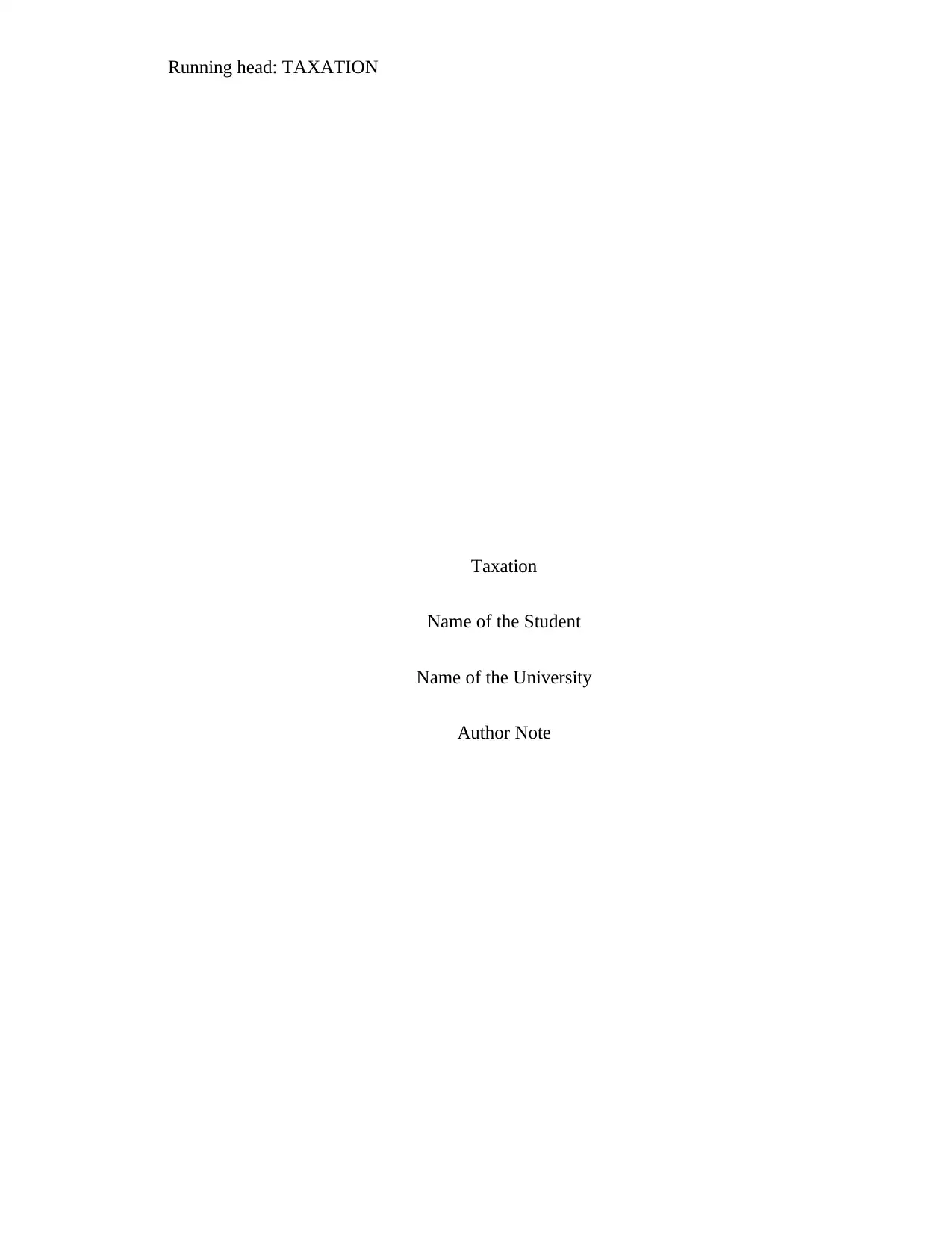
Running head: TAXATION
Taxation
Name of the Student
Name of the University
Author Note
Taxation
Name of the Student
Name of the University
Author Note
Paraphrase This Document
Need a fresh take? Get an instant paraphrase of this document with our AI Paraphraser
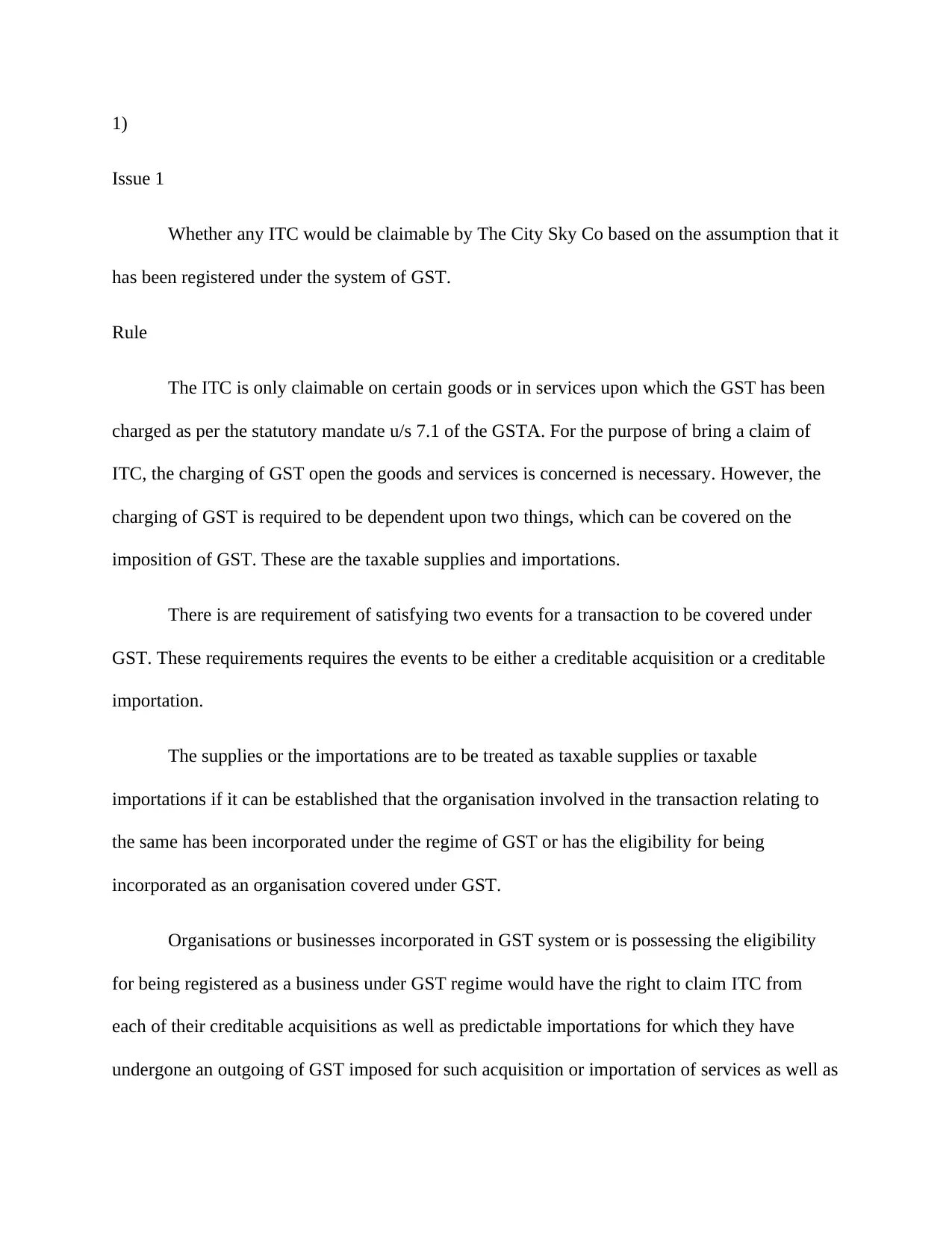
1)
Issue 1
Whether any ITC would be claimable by The City Sky Co based on the assumption that it
has been registered under the system of GST.
Rule
The ITC is only claimable on certain goods or in services upon which the GST has been
charged as per the statutory mandate u/s 7.1 of the GSTA. For the purpose of bring a claim of
ITC, the charging of GST open the goods and services is concerned is necessary. However, the
charging of GST is required to be dependent upon two things, which can be covered on the
imposition of GST. These are the taxable supplies and importations.
There is are requirement of satisfying two events for a transaction to be covered under
GST. These requirements requires the events to be either a creditable acquisition or a creditable
importation.
The supplies or the importations are to be treated as taxable supplies or taxable
importations if it can be established that the organisation involved in the transaction relating to
the same has been incorporated under the regime of GST or has the eligibility for being
incorporated as an organisation covered under GST.
Organisations or businesses incorporated in GST system or is possessing the eligibility
for being registered as a business under GST regime would have the right to claim ITC from
each of their creditable acquisitions as well as predictable importations for which they have
undergone an outgoing of GST imposed for such acquisition or importation of services as well as
Issue 1
Whether any ITC would be claimable by The City Sky Co based on the assumption that it
has been registered under the system of GST.
Rule
The ITC is only claimable on certain goods or in services upon which the GST has been
charged as per the statutory mandate u/s 7.1 of the GSTA. For the purpose of bring a claim of
ITC, the charging of GST open the goods and services is concerned is necessary. However, the
charging of GST is required to be dependent upon two things, which can be covered on the
imposition of GST. These are the taxable supplies and importations.
There is are requirement of satisfying two events for a transaction to be covered under
GST. These requirements requires the events to be either a creditable acquisition or a creditable
importation.
The supplies or the importations are to be treated as taxable supplies or taxable
importations if it can be established that the organisation involved in the transaction relating to
the same has been incorporated under the regime of GST or has the eligibility for being
incorporated as an organisation covered under GST.
Organisations or businesses incorporated in GST system or is possessing the eligibility
for being registered as a business under GST regime would have the right to claim ITC from
each of their creditable acquisitions as well as predictable importations for which they have
undergone an outgoing of GST imposed for such acquisition or importation of services as well as
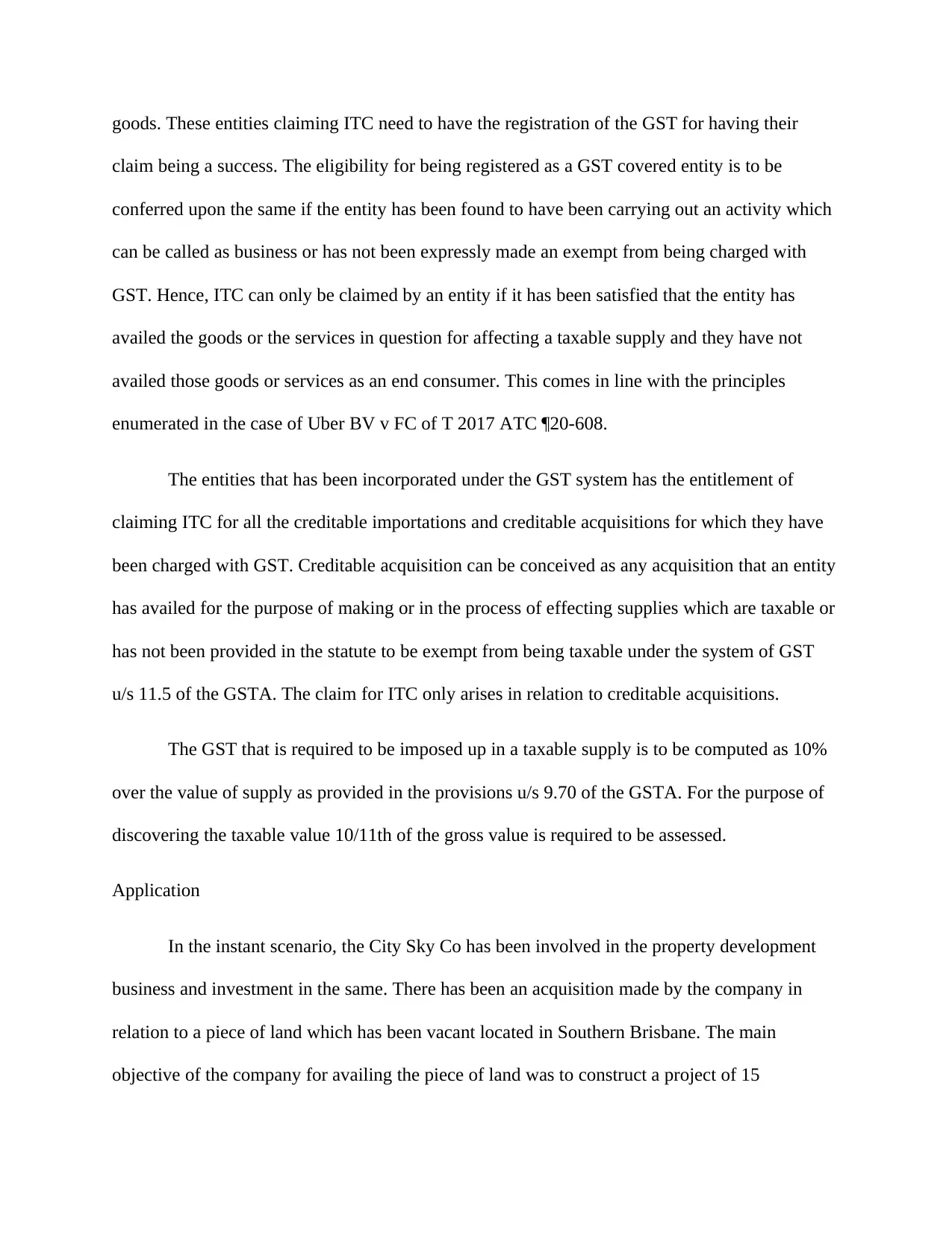
goods. These entities claiming ITC need to have the registration of the GST for having their
claim being a success. The eligibility for being registered as a GST covered entity is to be
conferred upon the same if the entity has been found to have been carrying out an activity which
can be called as business or has not been expressly made an exempt from being charged with
GST. Hence, ITC can only be claimed by an entity if it has been satisfied that the entity has
availed the goods or the services in question for affecting a taxable supply and they have not
availed those goods or services as an end consumer. This comes in line with the principles
enumerated in the case of Uber BV v FC of T 2017 ATC ¶20-608.
The entities that has been incorporated under the GST system has the entitlement of
claiming ITC for all the creditable importations and creditable acquisitions for which they have
been charged with GST. Creditable acquisition can be conceived as any acquisition that an entity
has availed for the purpose of making or in the process of effecting supplies which are taxable or
has not been provided in the statute to be exempt from being taxable under the system of GST
u/s 11.5 of the GSTA. The claim for ITC only arises in relation to creditable acquisitions.
The GST that is required to be imposed up in a taxable supply is to be computed as 10%
over the value of supply as provided in the provisions u/s 9.70 of the GSTA. For the purpose of
discovering the taxable value 10/11th of the gross value is required to be assessed.
Application
In the instant scenario, the City Sky Co has been involved in the property development
business and investment in the same. There has been an acquisition made by the company in
relation to a piece of land which has been vacant located in Southern Brisbane. The main
objective of the company for availing the piece of land was to construct a project of 15
claim being a success. The eligibility for being registered as a GST covered entity is to be
conferred upon the same if the entity has been found to have been carrying out an activity which
can be called as business or has not been expressly made an exempt from being charged with
GST. Hence, ITC can only be claimed by an entity if it has been satisfied that the entity has
availed the goods or the services in question for affecting a taxable supply and they have not
availed those goods or services as an end consumer. This comes in line with the principles
enumerated in the case of Uber BV v FC of T 2017 ATC ¶20-608.
The entities that has been incorporated under the GST system has the entitlement of
claiming ITC for all the creditable importations and creditable acquisitions for which they have
been charged with GST. Creditable acquisition can be conceived as any acquisition that an entity
has availed for the purpose of making or in the process of effecting supplies which are taxable or
has not been provided in the statute to be exempt from being taxable under the system of GST
u/s 11.5 of the GSTA. The claim for ITC only arises in relation to creditable acquisitions.
The GST that is required to be imposed up in a taxable supply is to be computed as 10%
over the value of supply as provided in the provisions u/s 9.70 of the GSTA. For the purpose of
discovering the taxable value 10/11th of the gross value is required to be assessed.
Application
In the instant scenario, the City Sky Co has been involved in the property development
business and investment in the same. There has been an acquisition made by the company in
relation to a piece of land which has been vacant located in Southern Brisbane. The main
objective of the company for availing the piece of land was to construct a project of 15
⊘ This is a preview!⊘
Do you want full access?
Subscribe today to unlock all pages.

Trusted by 1+ million students worldwide
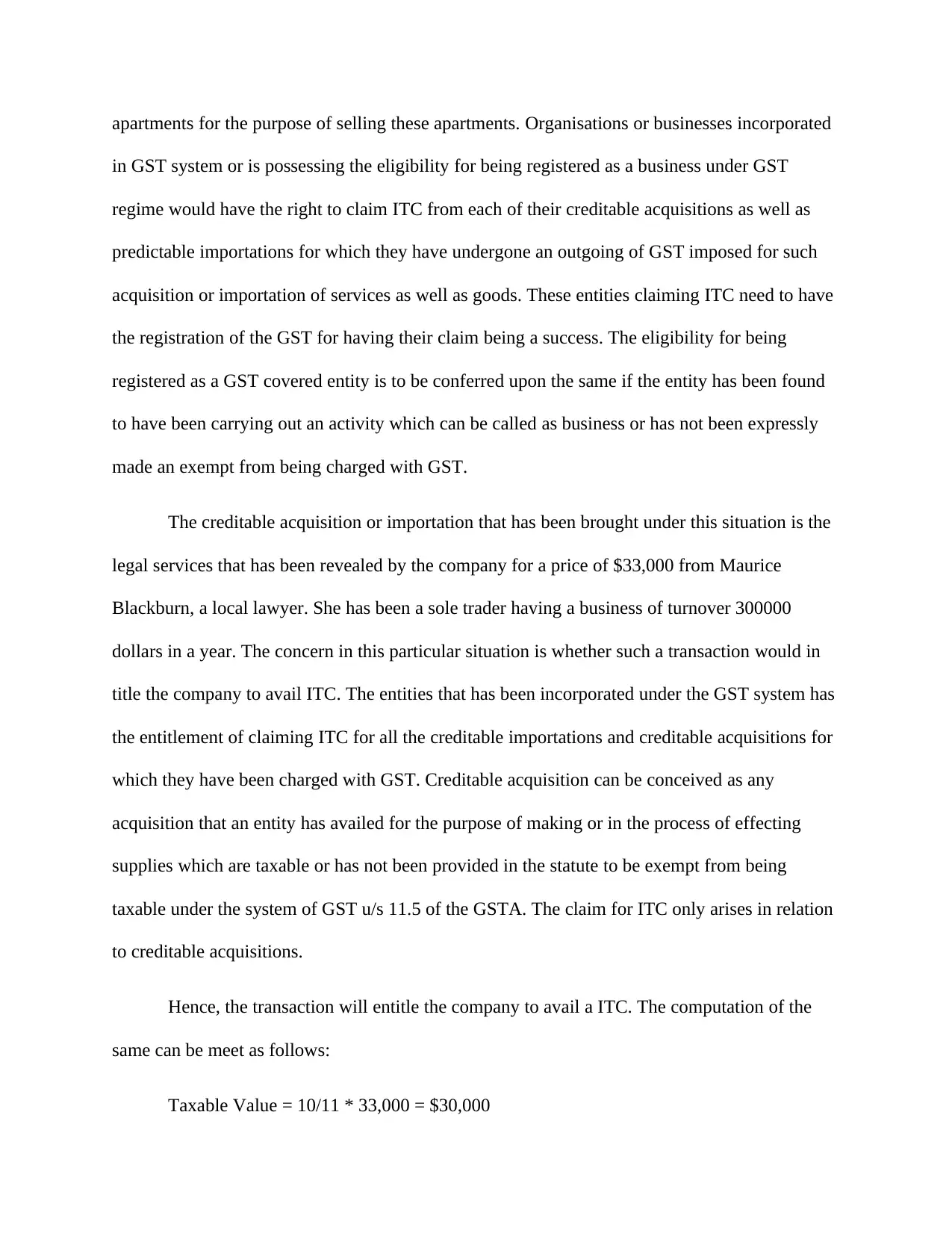
apartments for the purpose of selling these apartments. Organisations or businesses incorporated
in GST system or is possessing the eligibility for being registered as a business under GST
regime would have the right to claim ITC from each of their creditable acquisitions as well as
predictable importations for which they have undergone an outgoing of GST imposed for such
acquisition or importation of services as well as goods. These entities claiming ITC need to have
the registration of the GST for having their claim being a success. The eligibility for being
registered as a GST covered entity is to be conferred upon the same if the entity has been found
to have been carrying out an activity which can be called as business or has not been expressly
made an exempt from being charged with GST.
The creditable acquisition or importation that has been brought under this situation is the
legal services that has been revealed by the company for a price of $33,000 from Maurice
Blackburn, a local lawyer. She has been a sole trader having a business of turnover 300000
dollars in a year. The concern in this particular situation is whether such a transaction would in
title the company to avail ITC. The entities that has been incorporated under the GST system has
the entitlement of claiming ITC for all the creditable importations and creditable acquisitions for
which they have been charged with GST. Creditable acquisition can be conceived as any
acquisition that an entity has availed for the purpose of making or in the process of effecting
supplies which are taxable or has not been provided in the statute to be exempt from being
taxable under the system of GST u/s 11.5 of the GSTA. The claim for ITC only arises in relation
to creditable acquisitions.
Hence, the transaction will entitle the company to avail a ITC. The computation of the
same can be meet as follows:
Taxable Value = 10/11 * 33,000 = $30,000
in GST system or is possessing the eligibility for being registered as a business under GST
regime would have the right to claim ITC from each of their creditable acquisitions as well as
predictable importations for which they have undergone an outgoing of GST imposed for such
acquisition or importation of services as well as goods. These entities claiming ITC need to have
the registration of the GST for having their claim being a success. The eligibility for being
registered as a GST covered entity is to be conferred upon the same if the entity has been found
to have been carrying out an activity which can be called as business or has not been expressly
made an exempt from being charged with GST.
The creditable acquisition or importation that has been brought under this situation is the
legal services that has been revealed by the company for a price of $33,000 from Maurice
Blackburn, a local lawyer. She has been a sole trader having a business of turnover 300000
dollars in a year. The concern in this particular situation is whether such a transaction would in
title the company to avail ITC. The entities that has been incorporated under the GST system has
the entitlement of claiming ITC for all the creditable importations and creditable acquisitions for
which they have been charged with GST. Creditable acquisition can be conceived as any
acquisition that an entity has availed for the purpose of making or in the process of effecting
supplies which are taxable or has not been provided in the statute to be exempt from being
taxable under the system of GST u/s 11.5 of the GSTA. The claim for ITC only arises in relation
to creditable acquisitions.
Hence, the transaction will entitle the company to avail a ITC. The computation of the
same can be meet as follows:
Taxable Value = 10/11 * 33,000 = $30,000
Paraphrase This Document
Need a fresh take? Get an instant paraphrase of this document with our AI Paraphraser
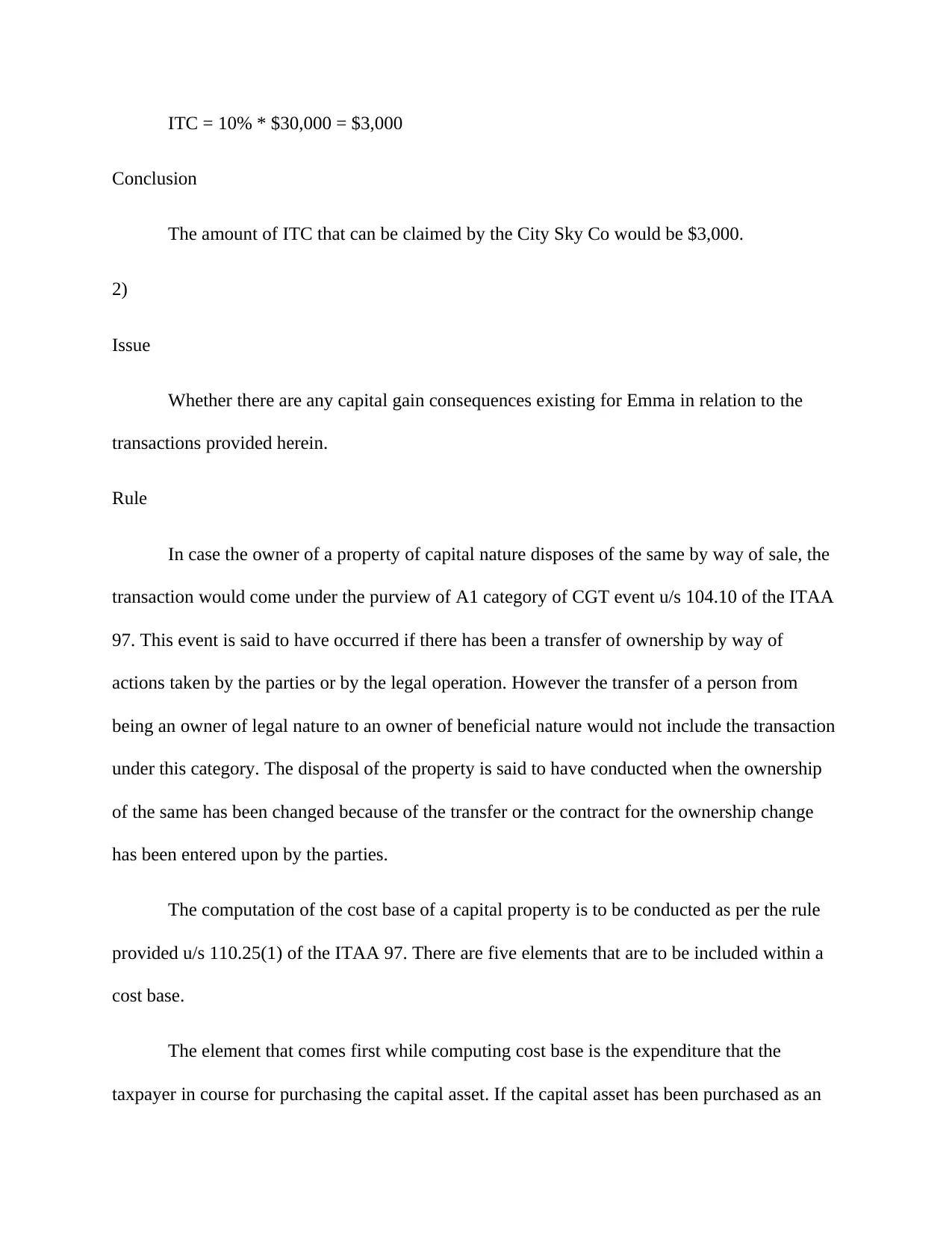
ITC = 10% * $30,000 = $3,000
Conclusion
The amount of ITC that can be claimed by the City Sky Co would be $3,000.
2)
Issue
Whether there are any capital gain consequences existing for Emma in relation to the
transactions provided herein.
Rule
In case the owner of a property of capital nature disposes of the same by way of sale, the
transaction would come under the purview of A1 category of CGT event u/s 104.10 of the ITAA
97. This event is said to have occurred if there has been a transfer of ownership by way of
actions taken by the parties or by the legal operation. However the transfer of a person from
being an owner of legal nature to an owner of beneficial nature would not include the transaction
under this category. The disposal of the property is said to have conducted when the ownership
of the same has been changed because of the transfer or the contract for the ownership change
has been entered upon by the parties.
The computation of the cost base of a capital property is to be conducted as per the rule
provided u/s 110.25(1) of the ITAA 97. There are five elements that are to be included within a
cost base.
The element that comes first while computing cost base is the expenditure that the
taxpayer in course for purchasing the capital asset. If the capital asset has been purchased as an
Conclusion
The amount of ITC that can be claimed by the City Sky Co would be $3,000.
2)
Issue
Whether there are any capital gain consequences existing for Emma in relation to the
transactions provided herein.
Rule
In case the owner of a property of capital nature disposes of the same by way of sale, the
transaction would come under the purview of A1 category of CGT event u/s 104.10 of the ITAA
97. This event is said to have occurred if there has been a transfer of ownership by way of
actions taken by the parties or by the legal operation. However the transfer of a person from
being an owner of legal nature to an owner of beneficial nature would not include the transaction
under this category. The disposal of the property is said to have conducted when the ownership
of the same has been changed because of the transfer or the contract for the ownership change
has been entered upon by the parties.
The computation of the cost base of a capital property is to be conducted as per the rule
provided u/s 110.25(1) of the ITAA 97. There are five elements that are to be included within a
cost base.
The element that comes first while computing cost base is the expenditure that the
taxpayer in course for purchasing the capital asset. If the capital asset has been purchased as an
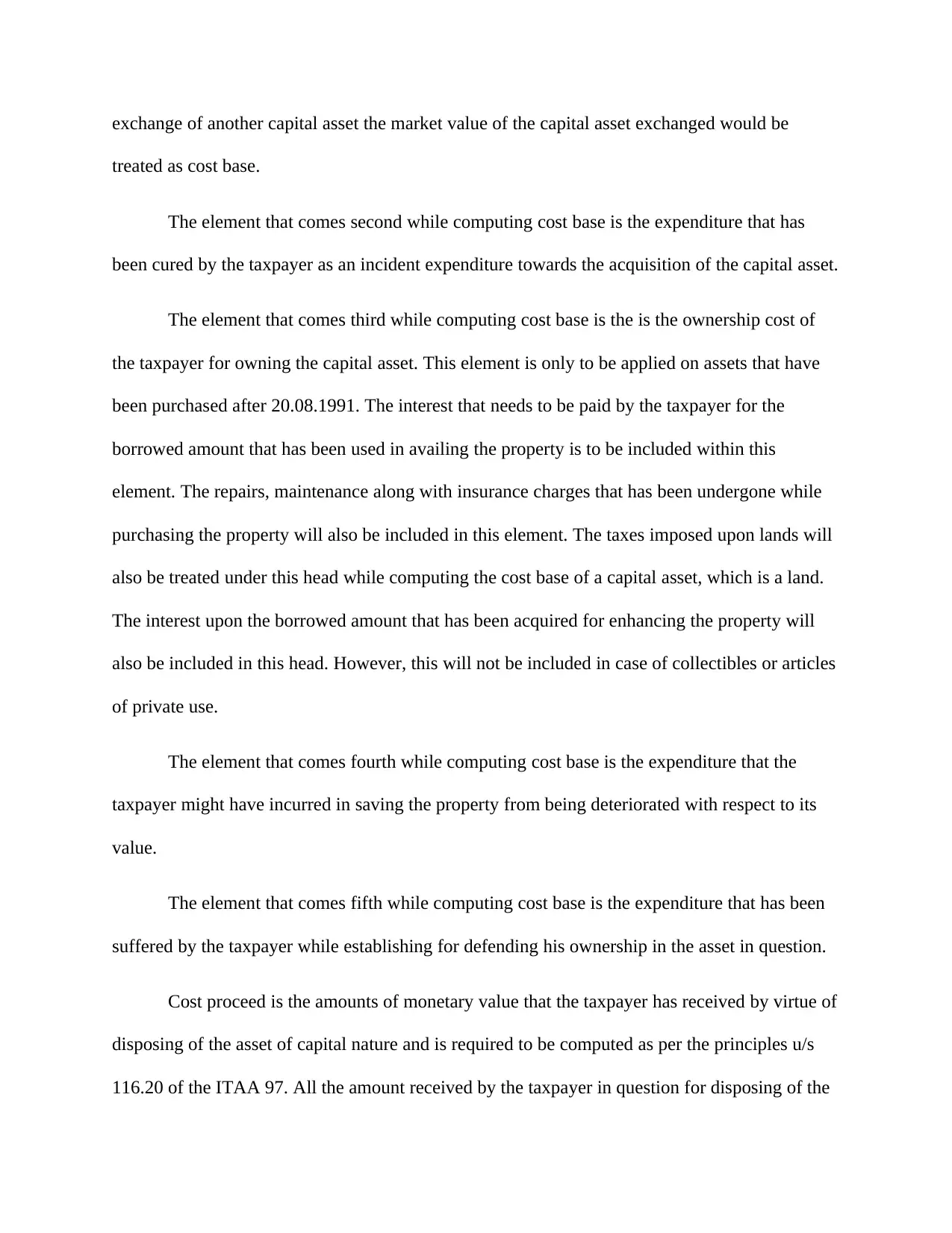
exchange of another capital asset the market value of the capital asset exchanged would be
treated as cost base.
The element that comes second while computing cost base is the expenditure that has
been cured by the taxpayer as an incident expenditure towards the acquisition of the capital asset.
The element that comes third while computing cost base is the is the ownership cost of
the taxpayer for owning the capital asset. This element is only to be applied on assets that have
been purchased after 20.08.1991. The interest that needs to be paid by the taxpayer for the
borrowed amount that has been used in availing the property is to be included within this
element. The repairs, maintenance along with insurance charges that has been undergone while
purchasing the property will also be included in this element. The taxes imposed upon lands will
also be treated under this head while computing the cost base of a capital asset, which is a land.
The interest upon the borrowed amount that has been acquired for enhancing the property will
also be included in this head. However, this will not be included in case of collectibles or articles
of private use.
The element that comes fourth while computing cost base is the expenditure that the
taxpayer might have incurred in saving the property from being deteriorated with respect to its
value.
The element that comes fifth while computing cost base is the expenditure that has been
suffered by the taxpayer while establishing for defending his ownership in the asset in question.
Cost proceed is the amounts of monetary value that the taxpayer has received by virtue of
disposing of the asset of capital nature and is required to be computed as per the principles u/s
116.20 of the ITAA 97. All the amount received by the taxpayer in question for disposing of the
treated as cost base.
The element that comes second while computing cost base is the expenditure that has
been cured by the taxpayer as an incident expenditure towards the acquisition of the capital asset.
The element that comes third while computing cost base is the is the ownership cost of
the taxpayer for owning the capital asset. This element is only to be applied on assets that have
been purchased after 20.08.1991. The interest that needs to be paid by the taxpayer for the
borrowed amount that has been used in availing the property is to be included within this
element. The repairs, maintenance along with insurance charges that has been undergone while
purchasing the property will also be included in this element. The taxes imposed upon lands will
also be treated under this head while computing the cost base of a capital asset, which is a land.
The interest upon the borrowed amount that has been acquired for enhancing the property will
also be included in this head. However, this will not be included in case of collectibles or articles
of private use.
The element that comes fourth while computing cost base is the expenditure that the
taxpayer might have incurred in saving the property from being deteriorated with respect to its
value.
The element that comes fifth while computing cost base is the expenditure that has been
suffered by the taxpayer while establishing for defending his ownership in the asset in question.
Cost proceed is the amounts of monetary value that the taxpayer has received by virtue of
disposing of the asset of capital nature and is required to be computed as per the principles u/s
116.20 of the ITAA 97. All the amount received by the taxpayer in question for disposing of the
⊘ This is a preview!⊘
Do you want full access?
Subscribe today to unlock all pages.

Trusted by 1+ million students worldwide
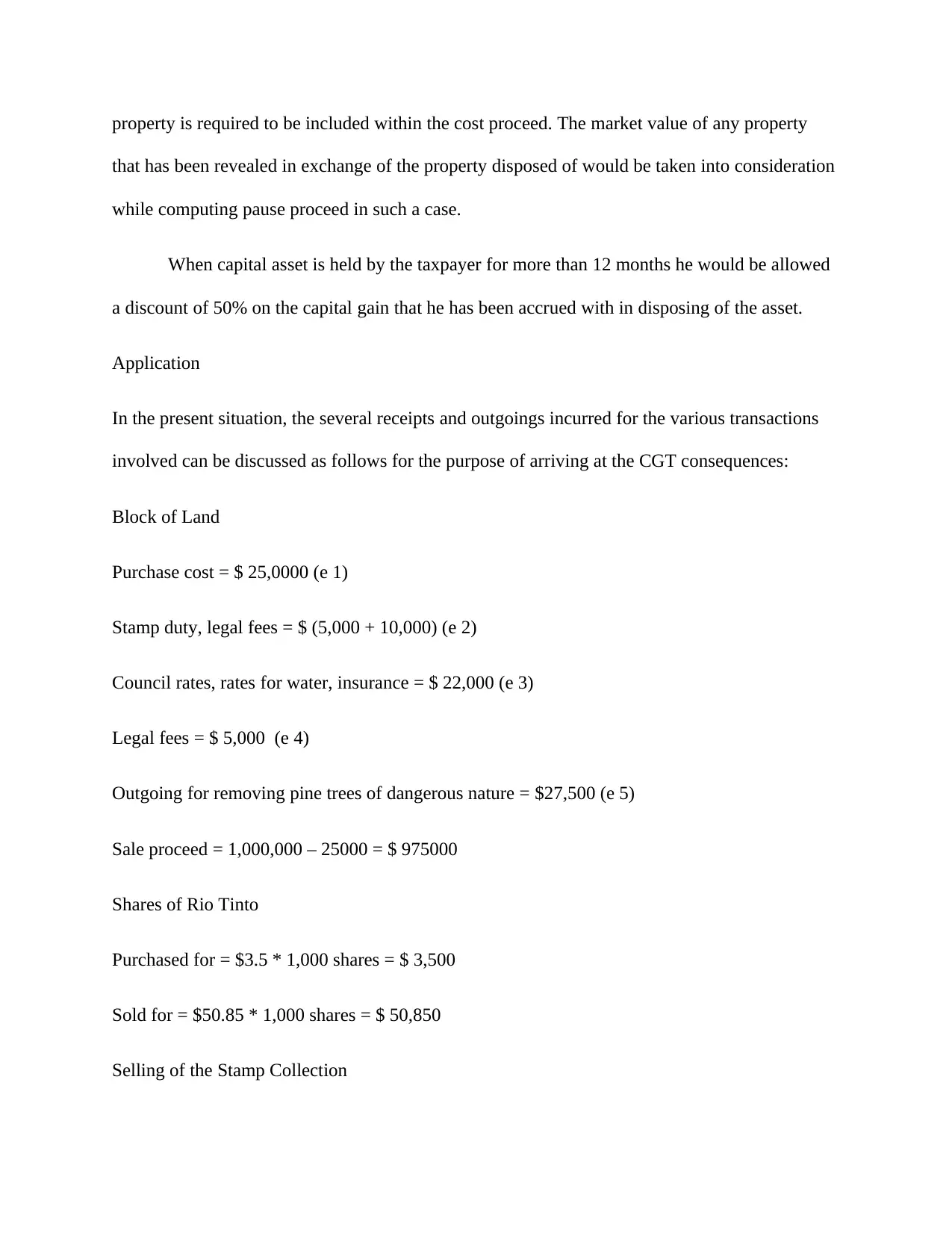
property is required to be included within the cost proceed. The market value of any property
that has been revealed in exchange of the property disposed of would be taken into consideration
while computing pause proceed in such a case.
When capital asset is held by the taxpayer for more than 12 months he would be allowed
a discount of 50% on the capital gain that he has been accrued with in disposing of the asset.
Application
In the present situation, the several receipts and outgoings incurred for the various transactions
involved can be discussed as follows for the purpose of arriving at the CGT consequences:
Block of Land
Purchase cost = $ 25,0000 (e 1)
Stamp duty, legal fees = $ (5,000 + 10,000) (e 2)
Council rates, rates for water, insurance = $ 22,000 (e 3)
Legal fees = $ 5,000 (e 4)
Outgoing for removing pine trees of dangerous nature = $27,500 (e 5)
Sale proceed = 1,000,000 – 25000 = $ 975000
Shares of Rio Tinto
Purchased for = $3.5 * 1,000 shares = $ 3,500
Sold for = $50.85 * 1,000 shares = $ 50,850
Selling of the Stamp Collection
that has been revealed in exchange of the property disposed of would be taken into consideration
while computing pause proceed in such a case.
When capital asset is held by the taxpayer for more than 12 months he would be allowed
a discount of 50% on the capital gain that he has been accrued with in disposing of the asset.
Application
In the present situation, the several receipts and outgoings incurred for the various transactions
involved can be discussed as follows for the purpose of arriving at the CGT consequences:
Block of Land
Purchase cost = $ 25,0000 (e 1)
Stamp duty, legal fees = $ (5,000 + 10,000) (e 2)
Council rates, rates for water, insurance = $ 22,000 (e 3)
Legal fees = $ 5,000 (e 4)
Outgoing for removing pine trees of dangerous nature = $27,500 (e 5)
Sale proceed = 1,000,000 – 25000 = $ 975000
Shares of Rio Tinto
Purchased for = $3.5 * 1,000 shares = $ 3,500
Sold for = $50.85 * 1,000 shares = $ 50,850
Selling of the Stamp Collection
Paraphrase This Document
Need a fresh take? Get an instant paraphrase of this document with our AI Paraphraser
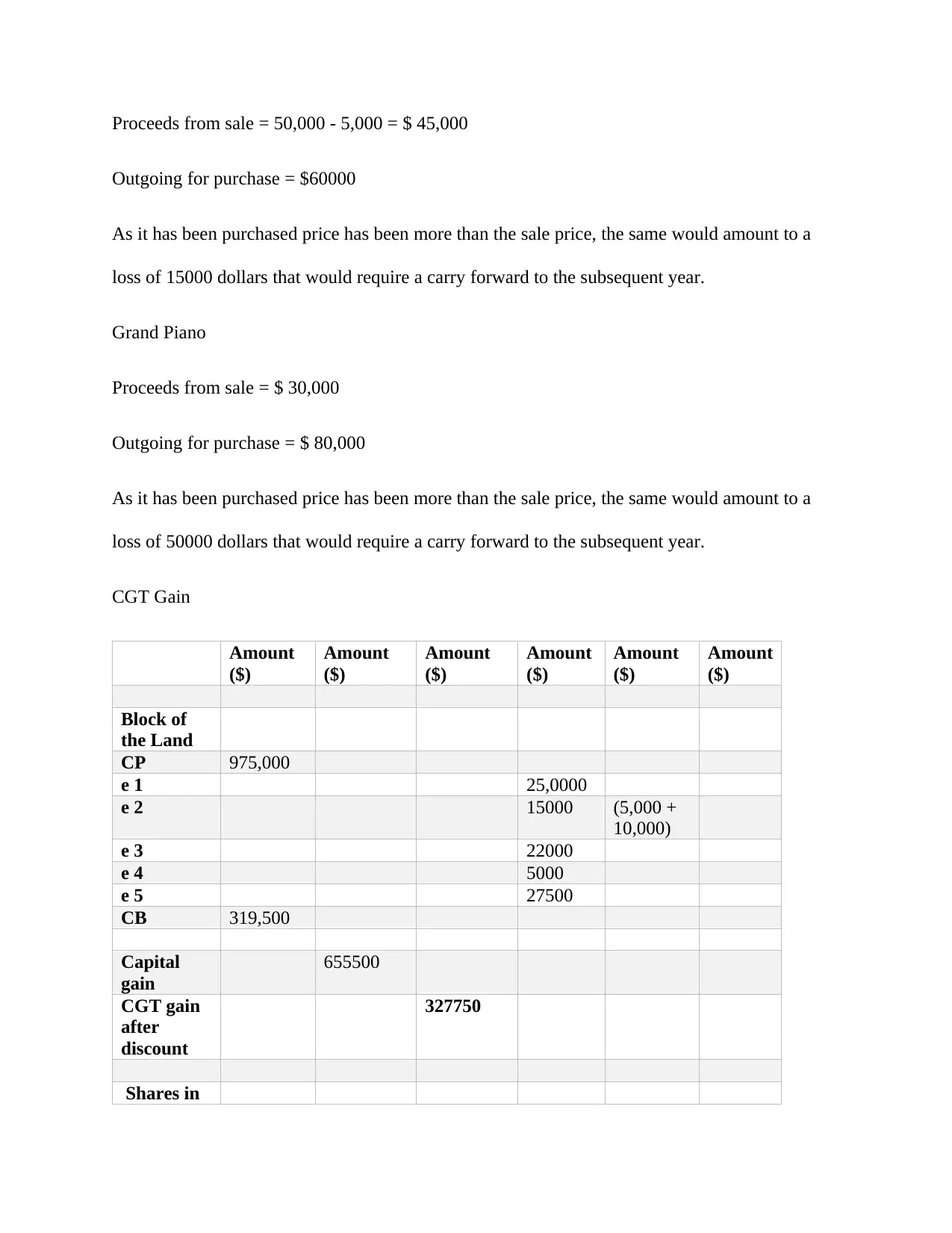
Proceeds from sale = 50,000 - 5,000 = $ 45,000
Outgoing for purchase = $60000
As it has been purchased price has been more than the sale price, the same would amount to a
loss of 15000 dollars that would require a carry forward to the subsequent year.
Grand Piano
Proceeds from sale = $ 30,000
Outgoing for purchase = $ 80,000
As it has been purchased price has been more than the sale price, the same would amount to a
loss of 50000 dollars that would require a carry forward to the subsequent year.
CGT Gain
Amount
($)
Amount
($)
Amount
($)
Amount
($)
Amount
($)
Amount
($)
Block of
the Land
CP 975,000
e 1 25,0000
e 2 15000 (5,000 +
10,000)
e 3 22000
e 4 5000
e 5 27500
CB 319,500
Capital
gain
655500
CGT gain
after
discount
327750
Shares in
Outgoing for purchase = $60000
As it has been purchased price has been more than the sale price, the same would amount to a
loss of 15000 dollars that would require a carry forward to the subsequent year.
Grand Piano
Proceeds from sale = $ 30,000
Outgoing for purchase = $ 80,000
As it has been purchased price has been more than the sale price, the same would amount to a
loss of 50000 dollars that would require a carry forward to the subsequent year.
CGT Gain
Amount
($)
Amount
($)
Amount
($)
Amount
($)
Amount
($)
Amount
($)
Block of
the Land
CP 975,000
e 1 25,0000
e 2 15000 (5,000 +
10,000)
e 3 22000
e 4 5000
e 5 27500
CB 319,500
Capital
gain
655500
CGT gain
after
discount
327750
Shares in
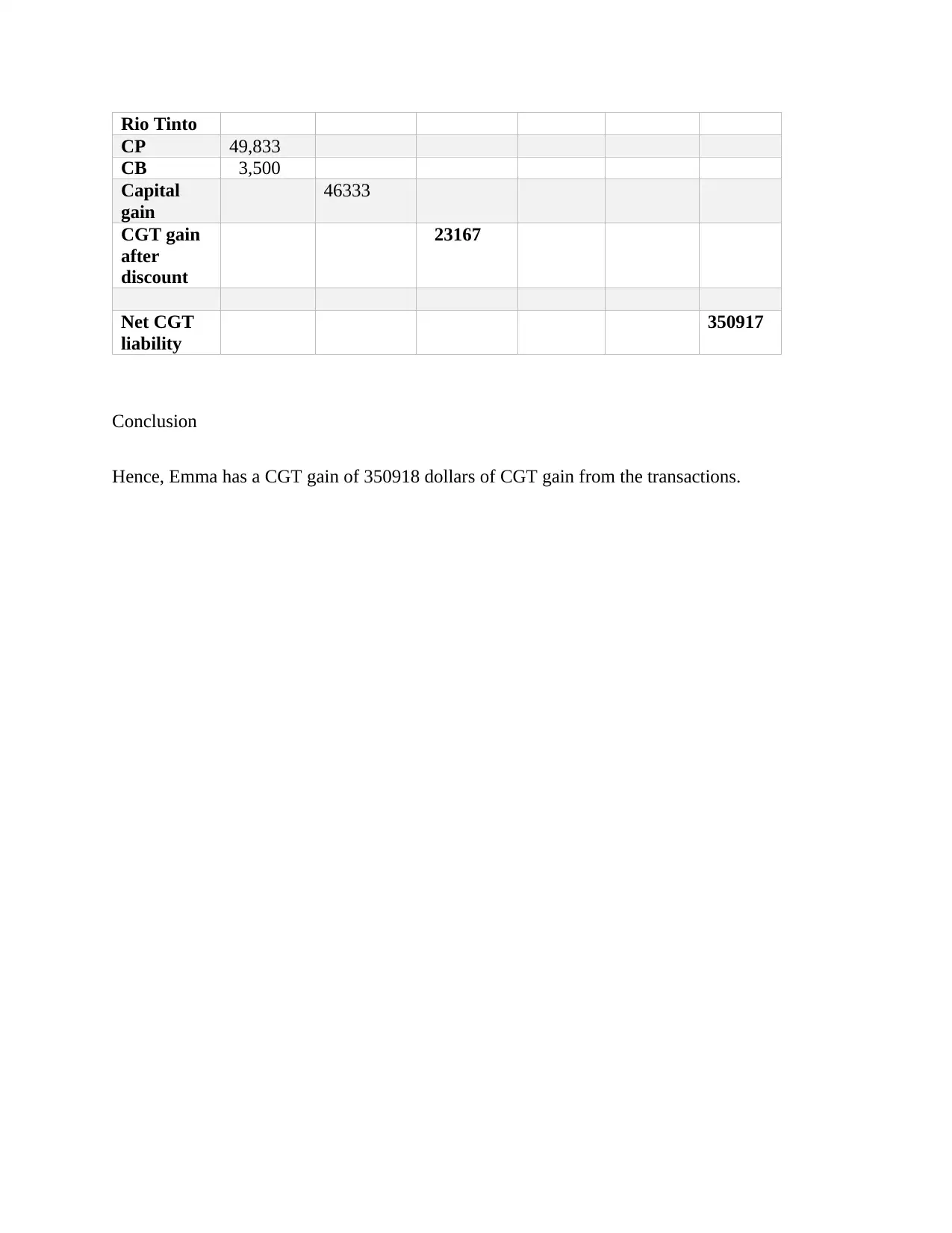
Rio Tinto
CP 49,833
CB 3,500
Capital
gain
46333
CGT gain
after
discount
23167
Net CGT
liability
350917
Conclusion
Hence, Emma has a CGT gain of 350918 dollars of CGT gain from the transactions.
CP 49,833
CB 3,500
Capital
gain
46333
CGT gain
after
discount
23167
Net CGT
liability
350917
Conclusion
Hence, Emma has a CGT gain of 350918 dollars of CGT gain from the transactions.
⊘ This is a preview!⊘
Do you want full access?
Subscribe today to unlock all pages.

Trusted by 1+ million students worldwide
1 out of 9
Related Documents
Your All-in-One AI-Powered Toolkit for Academic Success.
+13062052269
info@desklib.com
Available 24*7 on WhatsApp / Email
![[object Object]](/_next/static/media/star-bottom.7253800d.svg)
Unlock your academic potential
Copyright © 2020–2025 A2Z Services. All Rights Reserved. Developed and managed by ZUCOL.





